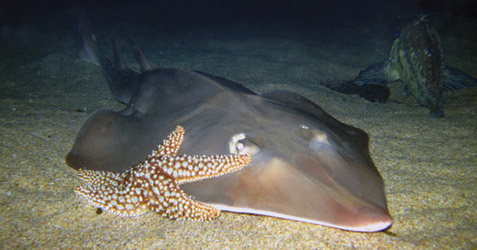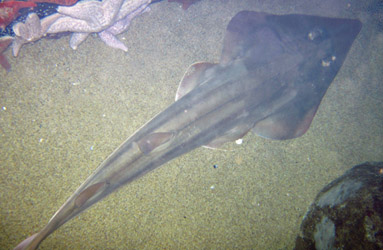While its movements will not result in the next chart-topping and head-banging hit, the new shovelnose guitarfish (Rhinobatos productus) at San Francisco’s Aquarium of the Bay—with its guitar-shaped body—wins the award of underwater rock star.

Shovelnose guitarfish are masters at the chord of “be flat,” as they hide in the sand waiting to ambush their prey. Photo by Keith Herbert: Aquarium of the Bay
By Kati Schmidt
Published: December, 2010
|
|
“Shovelnose guitarfish represent an evolutionary offshoot between sharks and rays,” said Michael Grassmann, an aquarist at Aquarium of the Bay who cares for its elasmobranchs species, including the shovelnose guitarfish, sharks, rays and skates.
The head of a shovelnose guitarfish resembles that of a ray or skate, with its long, pointed snout and a spade-shaped disc that is longer than it is wide. The head portion of the animal leads to a long tail with two shark-like dorsal fins. The shovelnose guitarfish is estimated to have swum in waters ranging from San Francisco Bay to the Gulf of California for more than 100 million years, taking preference to shallower waters for feeding and breeding.
It could be said that shovelnose guitarfish are masters at the chord of “be-flat,” as they use their sand coloring to help them camouflage and bury into the sand. An ambush predator, the animal hides in the sand and waits for prey such as flatfish and crabs to cross its path. When feeding calls for less active forms of hunting, its shovel-like rostrum or nose helps it dig into the sand for worms, clams and other shellfish.
Female shovelnose guitarfish are particularly abundant in San Francisco Bay in the spring, where females outnumber males 53 to 1—a rate that puts even “Bieber Fever” followers to shame. Females come into the Bay and other estuaries before males arrive, to give birth to their young after an 11-12 month gestation or pregnancy period, and utilize the Bay’s shallow waters and sandy bottoms as ideal nursery ground. Females can give birth to as many as 28 pups. Following the birth, males begin to join females in greater numbers, to have their own summer of love—or at least mating—before the cycle begins again.
The International Union for Conservation of Nature (IUCN) Red List, which evaluates the conservation status of animals on a global level, lists the shovelnose guitarfish as “near threatened,” due to commercial fishing in Baja and the Gulf of California. The bottom-dwelling animal is also often collected by accident as bycatch by shrimp and other fishermen. Other man-made threats include pollution and dredging of shallow water bays and estuaries, the animal’s nursery grounds.
A new shovelnose guitarfish recently joined the band of more than 20,000 aquatic animals at Aquarium of the Bay. Fans can see it conducting an underwater swimming duo with other shovelnose guitarfish in the near-shore Under the Bay exhibit, or burying itself in the sand when the fame becomes overwhelming.
Kati Schmidt is the Public Relations Manager for Aquarium of the Bay and The Bay Institute, nonprofit organizations dedicated to protecting, restoring and inspiring conservation of San Francisco Bay and its watershed. A Bay Area native and aspiring Great American novelist, Kati enjoys the professional and personal muses found from strolling and cycling along, and occasionally even swimming in San Francisco Bay and beyond.

From this angle the guitar-shaped body of the shovelnose guitarfish can be seen clearly. Photo by Keith Herbert: Aquarium of the Bay

